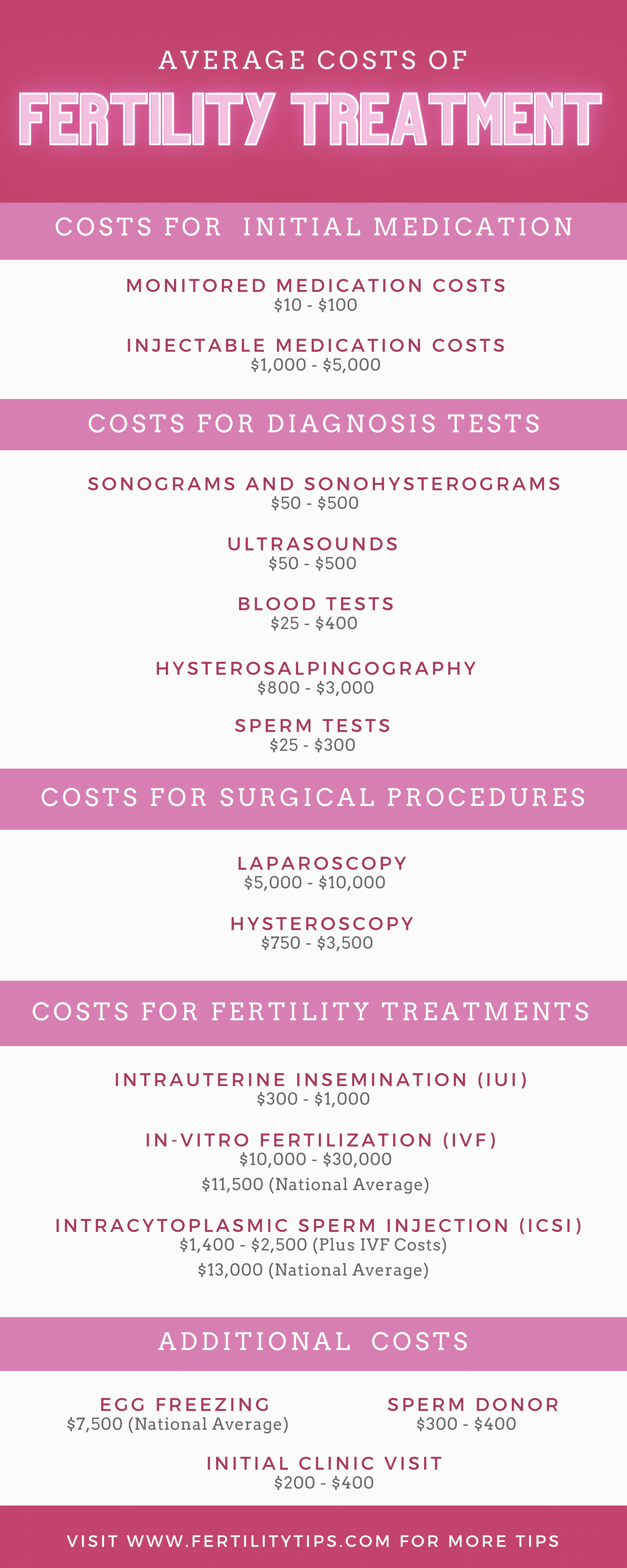Getting pregnant is not always easy. Between 10 and 15 percent of couples in the United States are deemed infertile. But all is not lost: infertility and fertility treatments are often a viable option for couples looking to get professional assistance in growing their family.
When it comes to the classification of infertility, a couple is labeled infertile after six to 12 months of trying to get pregnant with no success. While the causes of infertility are varied, treatment options can also range depending on the underlying issues. With the differences in fertility treatment however, come a large range of costs and expenses that can fluctuate depending on the type of infertility treatment, the geographic area one lives in, and other, often unknown, factors.
Seeking Medical Help with Infertility; Medications
After months of unsuccessful attempts at conception naturally, couples should consult with an OB for assistance.
The first option that many doctors will consider is medication to aid in regular ovulation. There are two main types of medications, clomiphene and gonadotropin. Both can regulate reproductive hormones and trigger an egg to be released from the ovaries each month.
The price of clomiphene mainly depends on whether it is generic or an alternative brand name that serves the same purpose. This method can range from $10 to $100 per month, and this medication can be taken up to six months. Gonadotropin costs more than clomiphene, as this is an injectable medication, which is administered in the doctor’s office, and the cost depends mainly on the dosage and the duration of the administration. The cost range for this medication can usually run from $1,000 to $5,000 per cycle.
By using medications for several months, doctors can typically rule out any physical reasons for infertility. This often requires a series of tests such as sonograms or sonohysterograms ($50 – $500), ultrasounds ($50 – $500), blood tests ($25 – $400), hysterosalpingography ($800-$3,000) or sperm tests ($25 – $300). These basic tests can vary in range depending on the type of test and the type of insurance coverage that is used and can range from $50 to typically a few hundred dollars depending on the test and how often they must be reevaluated.
Possible basic surgeries for the woman is also something that an OB can recommend. The costs will be dependent on the types of tests. Surgery will be the most expensive option in fertility evaluation, but if there is a blockage, for example in the fallopian tubes, this can often be corrected. Surgical procedures such as laparoscopy ($5,000 – $10,000) or hysteroscopy ($750 – $3,500), and can cost anywhere from $1,000 to $15,000 or more. The variance in costs is dramatic because it will depend on whether the surgery is outpatient or inpatient, how invasive the surgery is, and the nature of actual treatments.
Advancing to Further Medical Assistance to Overcome Infertility
Intrauterine Insemination
When medications and basic testing leads to a need for further medical assistance for overcoming infertility, the next step often taken during fertility treatments is intrauterine insemination (IUI). This will be an option for women who ovulate, either with or without medications, but still fail to get pregnant. For this procedure, the sperm are collected, either from the partner or a male donor, concentrated, and then injected directly into the uterus via a catheter at the time of ovulation. In general, this procedure can cost as low as $300 and extend up to $1,000, however, with this type of treatment, an average cost is approximately $865 per cycle. The procedure may need to be repeated more than once if the couple does not get pregnant the first time. Additional costs may include the medications needed to stimulate ovulation, a sonogram to ascertain ovulation has occurred, donor sperm if required, and additional labs and tests.
 In-Vitro Fertilization
In-Vitro Fertilization
In-vitro fertilization (IVF) is one of the more costly fertilization treatments when it comes to overcoming infertility. One reason is that this type of treatment is a multi-step process, requiring optimal timing and continuous medications and office visits. The first procedure is the removal of an egg from the woman’s ovary. In a lab, this egg is combined with either the partner’s sperm or donor sperm. Once fertilized, the resulting embryo is then implanted directly into the woman’s uterus. As with other treatments, the costs vary. An average cost of one cycle of IVF is approximately $12,400, however, these costs can range between $10,000 up to $30,000 per cycle depending on the medications, labs, geographical location of the patient and clinic, and underlying factors. It’s important to note that these costs are for only one cycle of IVF and for some couples the need for multiple cycles of IVF for a successful pregnancy is needed.
Intracytoplasmic Sperm Injection
Much like IVF, intracytoplasmic sperm injection (ICSI) differs from IVF in the way the sperm fertilizes the egg. In IUI, only one sperm is directly injected into an egg as oppose to many sperm being placed with an egg for fertilization. The ICSI procedure typically runs between $1,400 and $2,500 per cycle on top of the general IVF costs for medications and procedures.
Additional Fertility Treatments and Costs
There are always additional costs that can be factored into fertility treatment plans from clinic visit costs (which can run between $200 and $400, to additional procedures and add-ons, depending on the need. For example, as discussed above, the addition of ICSI to IVF will cost couples an extra $1,400 to $2,500 per cycle. However, if the couple decides that they need donor sperm, they will have to add an additional $300 to $400 per cycle that they use it. Donor sperm can be used with IUI, IVF, or ICSI.
Also, if the couple needs a donor egg, the costs will be even more. The couple will have to resort to treatment via IVF. One cycle of IVF with a fresh donor egg will cost the couple between $20,000 to $30,000. Using a frozen egg will lower the chances of pregnancy, but also the cost, which will be closer to $16,000.
In addition, the procedure of freezing eggs for future cycles can cost an average of $7,500.
Two other procedures known as GIFT and ZIFT are not regularly performed, though they were done in the past. In most cases, IVF has replaced these as safer and more reliable.
While fertility treatments are costly and emotionally draining, a couple that is fruitful will be exuberant. In the end, the fertility treatment costs will seem negligible if successful. The baby that is produced will be a gift that the family will find priceless.
 How to Prepare for Fertility Treatments and What to Plan For
How to Prepare for Fertility Treatments and What to Plan For
Coping with high fertility treatment costs can be quite tricky. You need to understand every aspect of the treatment and how you can prepare adequately. Here, we have listed several ways in which you can cope with the high fertility treatment cost and what you should plan for in advance.
- Get educated. The fertility path can be incredibly overwhelming and confusing to any couple. If you do not plan and research accordingly, you may find that it quickly emotionally and physically drains to you and your wallet. It helps to do thorough research on fertility treatments and the best doctors and clinic that will fit your needs adequately to plan the best approach for your situation.
- Get acquainted with health insurance benefits. Using insurance coverage to pay for infertility treatments can be incredibly helpful. However, health insurance may not always help with fertility costs. Even if some fertility treatments are included in your health insurance, there are always many stipulations involved. Therefore, know what your insurance covers and plan accordingly.
- Choose clinics wisely. While your local fertility facility may be convenient in terms of location or pricing, it may not be your best choice. Be sure to look into all your options and look for a facility that uses the most current technology for better results and to save you money in the long run.
- Focus on the success rate of the treatment. While budget planning is crucial, it should be secondary in your plans. It can be best if you focus on the success rate of the process. How much the cost of overcoming infertility can be directly relevant to how many cycles or repeat procedures you can be expected to need.
Generally, while mother nature may fail to deliver on your hopes of getting pregnant naturally, there are many viable options for you. In this modern age, fertility treatments have greatly improved, giving everybody the hope of having children of their own. When financially planning your approach to fertility treatments, it is worth noting that insurance coverage can differ, and costs for fertility testing and treatment can geographically vary significantly and be dependent on the level of competition between fertility clinics in an area. For those couples looking to raise money for their fertility treatment journey, a variety of grants and financial assistance programs accept applications and regularly award couples looking to grow their family.

 In-Vitro Fertilization
In-Vitro Fertilization How to Prepare for Fertility Treatments and What to Plan For
How to Prepare for Fertility Treatments and What to Plan For


